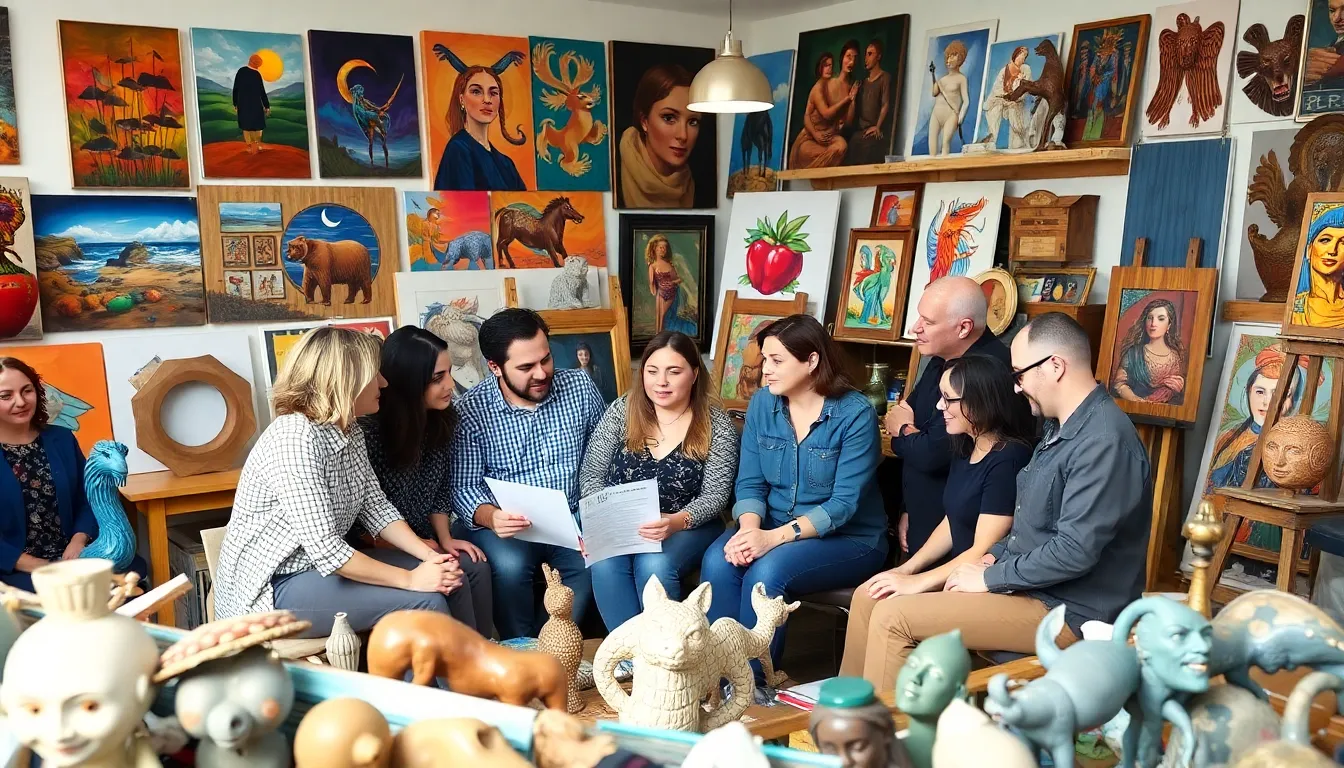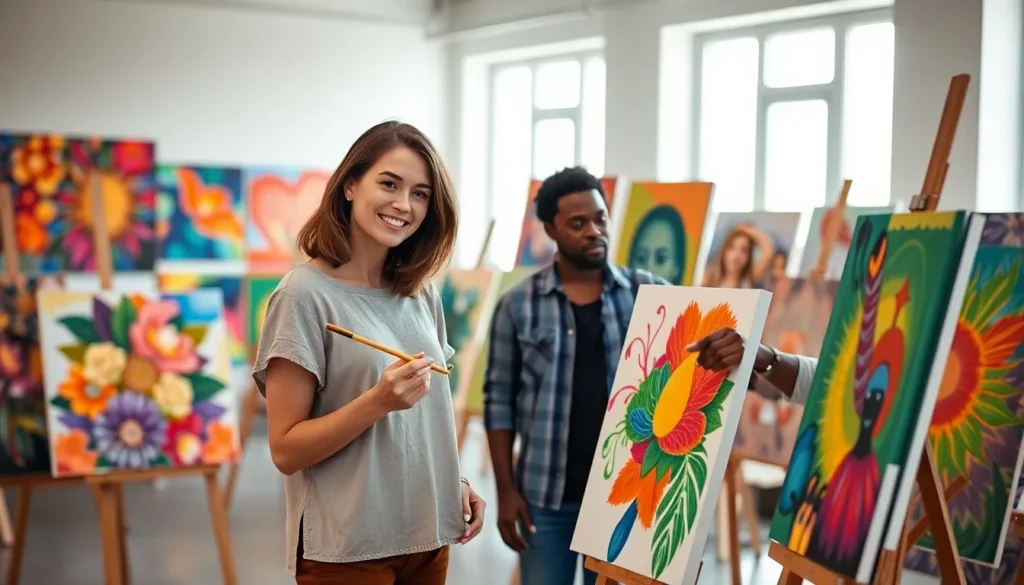Art licensing might sound like a fancy term reserved for the elite world of galleries and museums, but it’s actually an exciting opportunity for artists and businesses alike. Imagine turning your creative genius into a steady income stream without having to sell your soul—or your original artwork. By licensing their work, artists can see their designs on everything from greeting cards to yoga mats, all while keeping their masterpieces safely tucked away at home.
Table of Contents
ToggleOverview of Art Licensing
Art licensing represents a strategic approach for artists to monetize their creative work. Artists retain ownership of their original pieces while allowing businesses to use their designs on various products. With proper licensing agreements, artists can establish predictable revenue streams.
Many companies, such as greeting card and home decor brands, actively seek unique artwork to enhance their product offerings. Artists benefit financially from these opportunities, earning royalties or flat fees for their designs. Revenue models can vary; some agreements include upfront payments, while others offer ongoing royalties per product sold.
Understanding the terms of art licensing agreements remains crucial for artists. Licensing agreements typically outline the scope, duration, and territory of use. It’s essential to clarify whether the license grants exclusive rights or if the artist retains the ability to sell the same design to multiple clients.
Furthermore, artists may explore different types of licenses, such as merchandise licensing or publishing rights. Merchandise licensing allows companies to produce physical items featuring licensed artwork. Publishing rights pertain to the use of artwork in media like books or advertisements.
Establishing a strong portfolio enhances an artist’s marketability. A diverse collection of artwork can attract various clients. Networking within the industry and participating in trade shows can lead to beneficial partnerships.
Art licensing can empower artists, providing them a platform for exposure and income without sacrificing ownership of their creative output. The right agreements foster successful collaborations between artists and businesses, resulting in mutually beneficial outcomes.
Types of Art Licensing

Art licensing encompasses various types of agreements that define how artwork can be utilized. Understanding these types is crucial for artists seeking to maximize their opportunities in the market.
Exclusive vs. Non-Exclusive Licenses
Exclusive licenses grant a single entity the sole rights to use the artwork. This type of license often comes with higher royalties, as it limits competition in the market. Non-exclusive licenses, on the other hand, allow multiple entities to use the same piece of art. Artists benefit from this arrangement by diversifying their income streams. Flexibility is key in choosing between these options, as some artists prefer the stability of exclusivity while others thrive on broader exposure.
Limited vs. Unlimited Uses
Limited use licenses specify the exact ways the artwork can be applied, such as for a particular product line or timeframe. This approach provides clarity and control over the artist’s work. Unlimited use licenses offer broader rights, enabling the licensee to use the artwork in various applications without specified limitations. This can lead to a more unpredictable revenue stream for artists. Evaluating the potential outcomes of each license type is vital for aligning them with an artist’s business goals.
Benefits of Art Licensing
Art licensing provides significant advantages for both artists and businesses, fostering collaboration and financial growth. Understanding these benefits can enhance opportunities in the art market.
For Artists
Artists gain a reliable income through licensing agreements. By licensing their artwork, they can see their designs on various products, from home decor to apparel. Retaining ownership while generating revenue represents a strategic advantage. Many artists increase exposure and brand recognition by having their work featured in multiple markets. Networking plays a key role in securing licensing deals, often leading to collaborations with well-known brands. Assessing agreements helps artists understand their rights and duties, ensuring they align with their artistic vision.
For Businesses
Businesses benefit from art licensing by enhancing their product offerings. Unique artwork can differentiate a brand from competitors, attracting more customers. Licensing allows companies to access a diverse range of artwork without the need for in-house artists. Building partnerships with artists fosters innovation and creativity within product lines. Licensing agreements often come with minimal risks compared to creating original works, as companies can explore various designs without hefty investments. Establishing these collaborations opens avenues for both financial growth and brand loyalty.
Important Considerations in Art Licensing
Art licensing involves several critical considerations that artists and businesses should keep in mind to navigate this field successfully.
Legal Aspects
Understanding legal aspects is essential in art licensing. Copyright laws protect artists’ original works, ensuring they retain ownership. Licensing agreements should outline rights granted, specifying scope, duration, and territorial limits. Additionally, it’s vital for artists to review terms thoroughly before signing. Non-compliance with licensing terms can result in legal disputes, leading to financial loss. Seeking legal advice can help clarify complex clauses and protect against infringement. Correctly registered copyright offers defense in claims, enhancing artists’ positions in negotiations.
Negotiation Tips
Successful negotiations boost the chances of favorable licensing agreements. Initiating discussions requires clear communication about expectations and rights. Artists should establish their desired royalty rates upfront, backed by market research on similar works. Remaining flexible during negotiations can lead to mutually beneficial terms. Asking clarifying questions helps identify the company’s needs while showcasing the artist’s versatility. Consider proposing a trial period, allowing businesses to assess the artwork’s market potential. Gathering industry data strengthens an artist’s negotiating position, making the agreement more appealing to potential partners.
Art licensing offers a dynamic avenue for artists to monetize their creativity while maintaining ownership of their work. By understanding the nuances of licensing agreements and exploring various options, artists can establish sustainable income streams and enhance their visibility in the market.
For businesses, partnering with artists through licensing can lead to innovative product offerings and a competitive edge. As the art licensing landscape continues to evolve, both artists and companies can benefit from strategic collaborations that drive growth and foster creativity. Embracing this opportunity can lead to rewarding outcomes for all parties involved.



